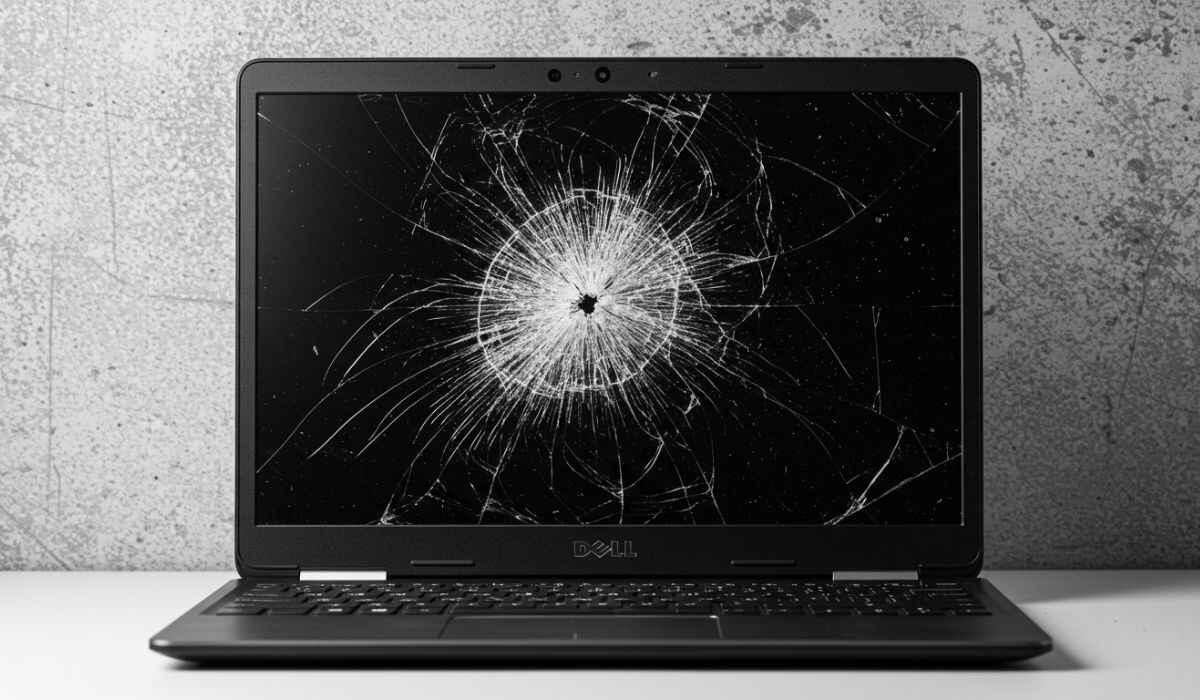Tiny irregularities in your display often point to pressure damage on the laptop screen. These flaws appear when layers inside the panel compress unevenly, causing dark circles, streaks, or blotches.
Identifying the exact pattern of screen pressure marks helps you choose the right remedy, whether it’s a home fix or professional replacement.
How Pressure Spots Form
- Overzealous hinge tension can press the lid too tightly against the bezel, creating pressure spots on the laptop screen at the hinge margins.
- Objects left on the keyboard, such as pens or USB sticks, lodge between the lid and base when you close the laptop. Those hard points press directly into the LCD layers.
- Carrying your machine in a tightly packed bag without padding concentrates force across the closed lid.
- Resting the laptop on uneven surfaces tilts one side downward, focusing weight on specific pixels.
Spotting the Difference Between Impact and Pressure Damage
Impact scratches or cracks tend to radiate from a single point of contact. In contrast, pressure damage on screen often shows diffuse shading or cloud-like smears in consistent shapes, circles, ovals, or elongated patches, that shift with viewing angles. Testing under a white or light-gray background in a dim room makes it easier to map these blemishes before you start repairs.
DIY Approaches to Fix Pressure Marks
1. Gentle Redistribution
Shut down the laptop, unplug the power, and cover the palm rest with a soft cloth. Using a fingertip or a microfiber cloth wrapped around your finger, apply very light circular pressure around each mark. This may ease internal fluid shifts and reduce the prominence of laptop display damage without risking further harm.
2. Controlled Warmth
To heal the blisters of a thermal burn, a hair dryer can be set to the lowest warm setting (around 40°C); low warm. In about 20-second intervals, move it in small sweeping motions about 10 cm over the damaged areas.
Follow immediately with the gentle redistribution step to help realign pixels. Warning: Excessive heat or direct contact with the panel risks permanent harm.
3. Air-Bladder Repair Kits
Specialized kits include small inflatable bladders you slip between the bezel and panel. Inflate just enough to press uniformly from behind, evening out uneven pressure. Repeat briefly in different spots to tackle multiple screen pressure marks. Only use kits designed for laptop screens and follow instructions to prevent cracking.
When to Engage a Technician
If blemishes remain after DIY attempts or worsen over days, professional servicing can diagnose deeper layer fractures. Technicians can:
- Disassemble the bezel and hinges safely.
- Replace the damaged LCD or entire panel when microfractures persist.
- Recalibrate hinge tension to prevent fresh pressure damage on the screen.
- Expect a panel swap on midrange laptops to cost roughly $80–$200.
If your machine still meets your needs otherwise, that investment may prove wiser than a new purchase.
Preventing Future Display Damage
Remove all loose items from the keyboard before closing the lid. Even a single pen can leave lasting pressure spots on the laptop screen.
- Check hinge tension periodically. Small adjustment screws near the hinges let you relieve overtightening.
- Please refer to the service manual.
- The laptop must generally be slipped into an appropriately padded sleeve or stiff casing that provides for just enough space between the lid and base so that any inadvertent pressure on the laptop is avoided.
- Make sure to place the laptop on flat surfaces only, free of any debris, so no one side acquires undue weight.
Routine Screen Inspections
Make it a habit to inspect your display monthly under uniform light. Early detection of subtle screen pressure marks gives you a better chance at simple fixes. If you notice fresh spots or streaks, apply the gentle redistribution technique before the blemish spreads.
Balancing Cost and Longevity
Minor pressure flaws can sometimes vanish after a bit of massage and warmth. When those steps fail, professional repair restores full clarity without the higher price of a new device. By pairing careful handling with occasional hinge checks and a protective case, you’ll keep pressure damage on laptop screens at bay for years.
Final Thoughts
Pressure damage may look alarming, but not every mark demands a full screen swap. Armed with the right methods, light massage, controlled heat, or an air-bladder tool, you can often clear or greatly reduce pressure spots on laptop screens.
If the display remains compromised, a technician’s LCD replacement gives you fresh glass at a fraction of the cost of a new machine. With vigilant prevention, you’ll avoid fresh laptop display damage and enjoy a crisp, unblemished view for the long haul.
